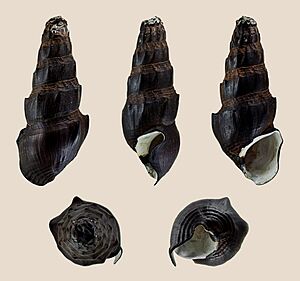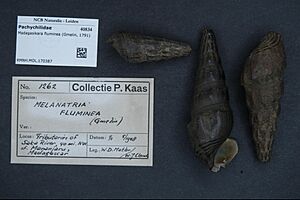Madagasikara spinosa facts for kids
Quick facts for kids Madagasikara spinosa |
|
|---|---|
 |
|
| Madagasikara spinosa | |
| Conservation status | |
| Scientific classification | |
| Kingdom: | |
| Phylum: | |
| Class: | |
| (unranked): |
clade Caenogastropoda
clade Sorbeoconcha |
| Superfamily: |
Cerithioidea
|
| Family: |
Pachychilidae
|
| Genus: |
Madagasikara
|
| Species: |
M. spinosa
|
| Binomial name | |
| Madagasikara spinosa (Lamarck, 1822)
|
|
| Synonyms | |
|
|
Madagasikara spinosa is a fascinating type of freshwater snail that lives in tropical areas. It's a kind of aquatic animal called a gastropod mollusc. Like fish, it breathes underwater using a special organ called a gill. It also has a unique "trapdoor" called an operculum that can close its shell opening.
This snail belongs to the family Pachychilidae. Madagasikara spinosa is also known as the main example, or type species, for its group, the genus Madagasikara.
Where Madagasikara spinosa Lives
This snail is found only in one place: the island of Madagascar. When an animal or plant is found only in one specific area, it is called endemic to that place.
It has been seen in East Madagascar. It also lives on nearby islands like Île Sainte-Marie. The first place scientists found this snail was in the rivers of Madagascar.
What Madagasikara spinosa Looks Like
The shell of Madagasikara spinosa is long and quite large. It has many turns, called whorls, usually between 5 and 11 of them. The shell can be brown or even black.
The very top part of the shell, called the apex, looks like it's cut off or flattened. You can often see raised lines or ridges on the shell, especially on the upper whorls. These are called axial ribs.
The opening of the shell, known as the aperture, is wide and oval-shaped. It has small indentations, or sinuses, at the top and bottom edges.
- The shell can be about 9.9 to 28.3 millimeters wide.
- It can be 25.2 to 69.5 millimeters tall.
- The opening itself is about 5.0 to 18.4 millimeters wide.
- The opening is about 8.0 to 23.1 millimeters tall.
The operculum, which is like a lid for the shell, is oval and black.
The snail's body is dark grey to black. It has small yellowish dots. Its tentacles (feelers) are quite long. The snail's tongue, called a radula, is special. It's about 16 millimeters long and has around 127 rows of tiny teeth!
Life and Habitat
Madagasikara spinosa prefers to live in streams where the water flows quickly.
When it comes to reproduction, these snails have separate sexes. This means there are male snails and female snails. The females lay eggs, which is how new snails are born.



